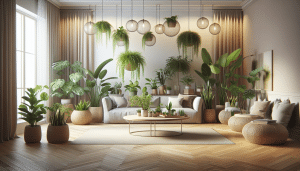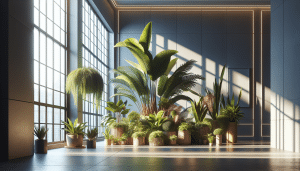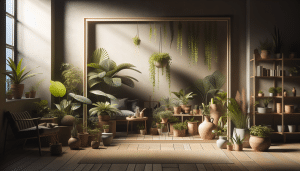Smart Ways You Can Transform Small Outdoor Spaces
Daniel Fisher September 28, 2025
Reimagining a compact yard or patio can feel challenging, but small outdoor spaces offer huge potential for style and enjoyment. This detailed guide will inspire you with expert strategies and creative ideas to maximize every corner, bringing both comfort and value to your home using proven backyard design techniques.
Unlocking the Potential of Small Outdoor Spaces
Many dream of a sprawling backyard, yet more often, homeowners find themselves working with modest patios, balconies, or pocket-sized gardens. It can feel limiting but the reality is these areas are ripe with possibility. With creative use of design principles and the right outdoor furnishings, even the smallest yard can become a welcoming retreat. A compact setting makes every choice impactful. Whether the goal is to entertain, relax, or cultivate plants, well-designed zones can boost enjoyment and functionality. Visual interest can be created with vertical planters, layered landscaping, and carefully chosen details that draw the eye upward or guide guests around the space.
One of the key strategies is to plan with intention. Before making changes, spend time observing how the sunlight shifts throughout the day and which sections feel most comfortable. This information can help in placing dining sets, reading nooks, or garden beds for optimal use. Multi-use furniture further maximizes what’s possible — consider benches with interior storage or foldable tables that can be tucked out of the way after meals. Choosing light, portable pieces encourages rearrangement for different occasions, keeping the patio or garden flexible and lively. Additionally, focusing on just one or two themes, such as a Mediterranean courtyard or modern minimalist hideaway, lends a cohesive look without appearing cluttered.
By prioritizing smart organization and intentional design choices, even a small outdoors can function just like an extra room of the home. It’s helpful to start with simple upgrades first, like adding weatherproof cushions for immediate comfort or hanging solar lights to extend evening use. From there, explore more transformative projects, such as vertical herb walls or compact water features. Each addition boosts both functionality and curb appeal, making daily life brighter while potentially increasing home value https://www.nifa.org/resource/strategies-enhancing-small-garden-spaces.
Creative Vertical Gardening for Limited Spaces
Small outdoor spaces often lack room for spreading garden beds, but vertical gardening solves this challenge with style. By layering plants on fences, trellises, or modular wall systems, it’s possible to add lush greenery without sacrificing precious floor area. Hanging pots, stacked planters, and grow bags open up vibrant design opportunities. Vertical systems not only maximize growing space, they can function as privacy screens or living art — drawing attention away from boundaries and creating focal points. These systems are particularly valuable for balcony dwellers, allowing gardeners to cultivate herbs, flowers, or even compact vegetables inches from the kitchen.
Vertical gardening offers both aesthetic and environmental benefits. Well-chosen plants improve air quality and help buffer temperature swings, while wall gardens can soften hard surfaces and attract birds or beneficial insects. Installation is typically straightforward. Many retailers offer ready-to-mount fabric planters or modular grids for simple DIY setup. Watering tends to be more manageable too, because gravity helps prevent soggy roots and encourages efficient use of resources. For those starting out, mixing trailing vines at the top with bushy or colorful plants below delivers dynamic results instantly.
Another advantage of vertical gardening is flexibility, allowing for seasonal change. Homeowners can update displays according to the time of year, rotating in cold-hardy succulents for winter or cascading blooms for spring. With careful plant selection, even shady walls become green havens, giving underused vertical surfaces new life. Experiment with containers to match your décor, from rustic wooden pallets to sleek steel pockets. Vertical gardens are more than a trend — they’re a lasting approach to beautiful, functional outdoor living https://extension.colostate.edu/topic-areas/yard-garden/vertical-gardening-2-242/.
Cozy Outdoor Furniture Solutions for Compact Areas
Furnishing a compact outdoor area means finding just the right balance between comfort, function, and aesthetics. Oversized sofas or heavy wrought-iron tables quickly dominate the space. That’s why savvy designers suggest seeking out pieces made for small patios, such as slimline benches, stackable chairs, or modular seating that can be easily rearranged. Teak, powder-coated metal, or all-weather resin are popular options, blending durability with lightness. Add colorful, water-resistant cushions to boost both comfort and visual interest, drawing people outdoors even during brief breaks in the day. Incorporating furniture that does double duty, like ottomans with storage or tables that fold away, helps eliminate clutter and keeps movement fluid.
When floor space is at a premium, the edges and corners become prime real estate. Tuck a bistro set into a sunny alcove or nestle a hammock chair beside the garden for an instant reading nook. Wall-mounted drop-leaf tables can provide dining for two, then pack flat when not in use. Modular furniture options are increasing on the market, allowing homeowners to personalize layouts according to need. These adaptable pieces make entertaining easier, turning a morning coffee spot into a gathering area with a quick shift in configuration.
Accents like outdoor rugs help define zones and inject pattern or color without overwhelming the setting. Lanterns, string lights, or sleek LED fixtures make the area inviting after sundown. It’s essential to maintain enough clear paths for easy movement. Selecting a consistent palette for furniture and accessories ties the area together visually, providing a sense of unity and tranquility. Small adjustments often have the biggest impact — a true hallmark of thoughtful backyard design https://content.ces.ncsu.edu/smart-gardening-for-small-spaces.
Integrating Nature with Smart Plant Choices
No matter how diminutive the space, greenery breathes life into any outdoor setting. Smart plant selection is crucial; consider sun exposure, wind direction, and individual maintenance needs. Dwarf varieties of trees and shrubs fit neatly into tight corners, while ornamental grasses and perennials bring movement and softness with minimal upkeep. Grouping plants in odd-numbered clusters creates a natural look, and mixing heights adds dimension. Raised beds or containers are highly effective for controlling soil quality and deterring pests, making gardening success easier even for beginners.
For those drawn to edible landscapes, herbs like basil, thyme, and chives do well in containers and supply fresh flavor for meals. Strawberries, cherry tomatoes, or salad greens are also manageable in bowls or troughs, providing both color and culinary delight. Choosing natives or drought-resistant species further increases resilience and cuts down on watering, offering sustainability and savings over time. Layering bloom times means there’s always something interesting to see — from early crocuses to late-autumn asters.
Gardens in small spaces have become not only practical but beautiful sanctuaries for pollinators. Selecting butterfly-friendly plants or hanging seed feeders attracts bees, birds, and beneficial insects. Tucking in fragrant blooms like lavender or night phlox creates multisensory enjoyment and can help repel pests. By thinking strategically about plant placement and variety, any small outdoor zone can become a thriving, low-maintenance oasis https://extension.umn.edu/lawn-care/smarter-gardening-small-spaces.
Lighting Techniques for Comfort and Atmosphere
Lighting is a game-changer for transforming small outdoor areas. It allows use well into the evening while also helping define distinct areas within one space. Soft, ambient lighting — such as solar-powered string lights or LED lanterns — enhances coziness without creating glare. Place lanterns along paths to highlight features, or intersperse fairy lights through foliage for a magical touch. Portable battery-operated lamps let you experiment with placement for every gathering or quiet moment outdoors.
Layered lighting fosters a sense of depth. Position spotlights to accent a special tree or statement planter, while indirect uplighting along a fence can make boundaries seem to fade, widening the feel of the yard. Solar stake lights are efficient and require no special wiring, making them ideal for renters or those who want a fuss-free option. The play of shadow and light helps mask sharp angles, contributing to a more nurturing, intimate setting.
Safety is just as important as atmosphere when designing small outdoor lighting schemes. Use motion-sensor fixtures at entrances or stairways, and be mindful to shield light to avoid disturbing neighbors. Warm-colored lights generally create more relaxing environments and work well with natural décor elements. Experiment with twinkle lights, candle-style bulbs, or hidden LED strips to match the mood and highlight your favorite features. Thoughtful lighting sets the stage for memorable evenings outdoors https://hgic.clemson.edu/factsheet/landscape-lighting/.
Effortless Upkeep and Sustainable Outdoor Living
Maintenance is a make-or-break factor for small yards or patios. Streamlining care routines ensures these areas remain inviting, not overwhelming. Emphasize drought-tolerant and disease-resistant plants, which require less intervention and fewer resources. Mulching beds reduces weeds and retains moisture. Opt for slow-growing groundcovers as a living replacement for grass, eliminating frequent mowing or edging. Limit clutter by regularly storing tools in outdoor bins or concealed storage benches. A trim, tidy space is easier to enjoy and less prone to pest troubles.
Integrating sustainable practices is straightforward in a small area. Install rain barrels for watering gardens, or incorporate permeable pavers to help manage stormwater. Compost organic waste from the kitchen to feed the garden naturally, reducing reliance on synthetic fertilizers. Choose responsibly manufactured furniture and locally grown plants for a further reduction in your environmental footprint. These steps support nature, save money, and foster a feeling of stewardship among urban and suburban gardeners alike.
Time saved on upkeep can be spent enjoying the outdoor haven you’ve created. Low-maintenance doesn’t mean boring — it means more peace and flexibility for spontaneous gatherings or quiet afternoons. Sustainability and thoughtful design go hand in hand, showing that anyone can create a special, beautiful retreat just steps from the back door, regardless of lot size https://www.epa.gov/soakuptherain/soak-rain-rain-gardens.
References
1. National Institute of Food and Agriculture. (n.d.). Strategies for Enhancing Small Garden Spaces. Retrieved from https://www.nifa.org/resource/strategies-enhancing-small-garden-spaces
2. Colorado State University Extension. (n.d.). Vertical Gardening. Retrieved from https://extension.colostate.edu/topic-areas/yard-garden/vertical-gardening-2-242/
3. North Carolina State University Extension. (n.d.). Smart Gardening for Small Spaces. Retrieved from https://content.ces.ncsu.edu/smart-gardening-for-small-spaces
4. University of Minnesota Extension. (n.d.). Smarter Gardening for Small Spaces. Retrieved from https://extension.umn.edu/lawn-care/smarter-gardening-small-spaces
5. Clemson University Cooperative Extension. (n.d.). Landscape Lighting. Retrieved from https://hgic.clemson.edu/factsheet/landscape-lighting/
6. United States Environmental Protection Agency. (n.d.). Soak Up the Rain: Rain Gardens. Retrieved from https://www.epa.gov/soakuptherain/soak-rain-rain-gardens








